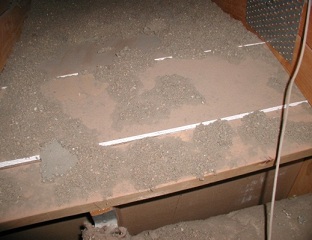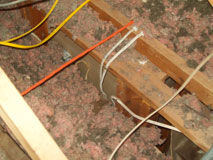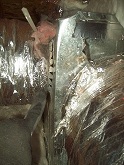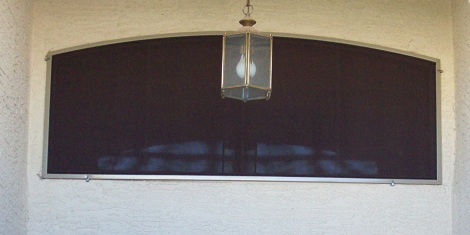- Prescott & Tucson (928) 445-3828
- Phoenix Metro (623) 939-3329
- Prescott & Tucson (928) 445-3828
- Phoenix Metro (623) 939-3329
Our auditors often see brand new high efficiency equipment installed in homes with a variety of building defects that degrade the home’s efficiency. These homes have missing insulation, major air leaks, leaky duct systems and other issues. We wonder why these customers spent the extra money on high efficiency equipment when what they should have invested in was medium efficiency equipment and repaired the problems that make their air conditioners run. The efficiency of the mechanical equipment is not nearly as critical when a house has incorporated intelligent cooling load reduction strategies.
In many homes in Phoenix, we could reduce the cooling load by 15% to 35%. It is not a difficult task, given that there are so many lost opportunities to cost effectively reduce a home’s cooling load. This article will provide five basic strategies to achieve major cooling load reduction. If your home has legitimate problems, you will most likely be eligible for rebates for four out these five recommendations.
The contracting community does a poor job of keeping the heat out of homes in Phoenix. The most common problems encountered are missing insulation, air barrier issues, duct leakage, door closure in single-return homes and a lack of solar control. It is my observation that there are few contractors who are clearly assessing the whole house and coming up with whole house solutions specific to a customer’s home.
For anyone who is genuinely committed to cost effectively reducing their cooling load, the first step is to have a $99 energy audit performed. This is an energy audit that APS, SRP and UniSource promote.The potential for cooling load reduction all depends on the individual house and magnitude of the problems a comprehensive energy audit reveals.
The most cost effective cooling load reduction strategies are:
Successfully apply these solutions to a home and a homeowner will achieve a level of efficiency and comfort most homeowners are not accustomed to.
It is important to keep in mind how these problems work in concert. A house that has substandard insulation and lacks solar control will call for more cooling which in turn will exacerbate duct leakage and door closure problems. One problem builds on another.
One opportunity to reduce cooling loads and increase comfort would be to eliminate the common thermal defects that undermine R-value. What is important to realize about insulation is that small problems can seriously undermine the overall R-value of an attic. Most people don’t realize that 5% missing insulation in an attic drops the overall R-value of the insulation 54%.
 |
 |
 |
| Missing insulation in attic | Living room ceiling temp | Infrared picture |
At Advantage Home Performance we routinely perform infrared scans and “see” missing insulation. It is not unusual to see interior sheet rock reach 111 ˚F. The key thing to remember with insulation is that every attic is different and must be inspected to be able to accurately calculate savings.
Another opportunity involves controlling unwanted infiltration. Weather stripping of windows and doors is the first thing that comes to mind when we mention air leakage in a home. However, while helpful, these measures are only a small part of the story. A much more sophisticated understanding of infiltration has emerged during the past twenty years. We now find that most of the air leaks are between the house and the attic.
 |
 |
|
| Air leakage problem at ceiling height change | Air barrier installed to solve problem |
The key to getting great insulation value is not to be focused on the rated value, but more on the quality of the installation. A quality R-30 will outperform a poorly installed R-38. A thorough job is more important.
A research paper by Proctor Engineering Group found that, “duct leakage and existing duct insulation levels reduce overall cooling efficiency. Reasonable improvements can save 16% of the cooling energy for about $140 each summer.” Yet, to this day, many HVAC contractors do not take responsibility for the air distribution system.
 |
 |
|
| Common duct leaks are dark areas | Disconnected supply duct in attic |
We also deal with door closure issues which are created when the air handler is running and a bedroom door is closed in a single return house. Many people have observed how a bedroom door will begin to close on it is own when it is almost shut when the air handler is running. The supply air that is being delivered to the bedroom will actually push the door shut. This phenomenon is called door closure and it has quite a significant impact on the infiltration rate.
In the photographs below the auditor is measuring the air flow being delivered into the master bedroom with a flow hood and on the other side of the same door he is measuring the positive pressure created in the bedroom because the supply air is trapped in the bedroom. When the air handler is running and the master bedroom door is closed the three supply registers deliver air that cannot get back to the return. The bedroom goes under a positive pressure and that conditioned air is forced out through every leak in the bedroom.
 |
 |
|
| Measuring air flow with flow hood | Measuring room pressures |
There are several solutions to door closure. The first is to add a return to the bedroom. The second is a jump duct so the supply air can make it back to the return. As part of the audit process we measure room pressures and propose solutions.
Probably the biggest opportunity to reduce your cooling load is with solar control strategies. When a house is insulated correctly and the duct system has minimal leakage, unwanted solar heat gain can account for 40% – 50% of the cooling load. In Phoenix solar heat gain must be controlled for a house to be energy efficient.
Having clear dual pane windows without solar control is the equivalent of having an un-insulated attic. Placing shade screens over clear dual pane windows on the east or west side of a house reduces the heat gain by 53%. The evidence to support this is readily available in Manual J Residential Load Calculation. The heat transfer multiplier (HTM) is an actual measure of energy performance for a building component. The lower the HTM the better. For a clear East or West facing window the HTM is 78. Add a 90% shade screen over the window and the HTM drops to 37.
 |
 |
|
| Before – without shade screen | After – with shade screen |
The savings potential with solar control strategies are substantial. According to a University of Texas at Austin study on solar control, “the annual energy cost savings for the top strategy (solar screens with the best properties) range from 10% – 14%.” This study corresponds with the savings SRP has projected, that is, in a typical 2000 square foot home, the average summer savings during summer months would be $275. On their web site APS states “you could reduce the size of your air conditioning unit by ½ to 1 ton with properly applied window shading techniques.”
It simply does not make sense to spend thousands more in high efficiency AC equipment without addressing the building defects that make your mechanical unit run in the first place. The most efficient air conditioning unit on the market is the one that does not run. This is why it wise to invest in improving the efficiency of your home at the same time you replace equipment.
Your utility company wants to help you improve the efficiency of your new home. With exception of jump ducts, the utilities all provide rebates for the shade screens, air barrier work, insulation and duct sealing. These are great programs that buy down the cost of energy conservation improvements. What makes Advantage Home Performance unique is that we perform all of these services including the energy audit.
The return on investment on these efficiency upgrades will be 10%, and possibly depending on the magnitude of the problems. With rebates and tax credits the ROI could be much greater. Also, these energy efficiency upgrades can have a positive impact on the resale value of the home.